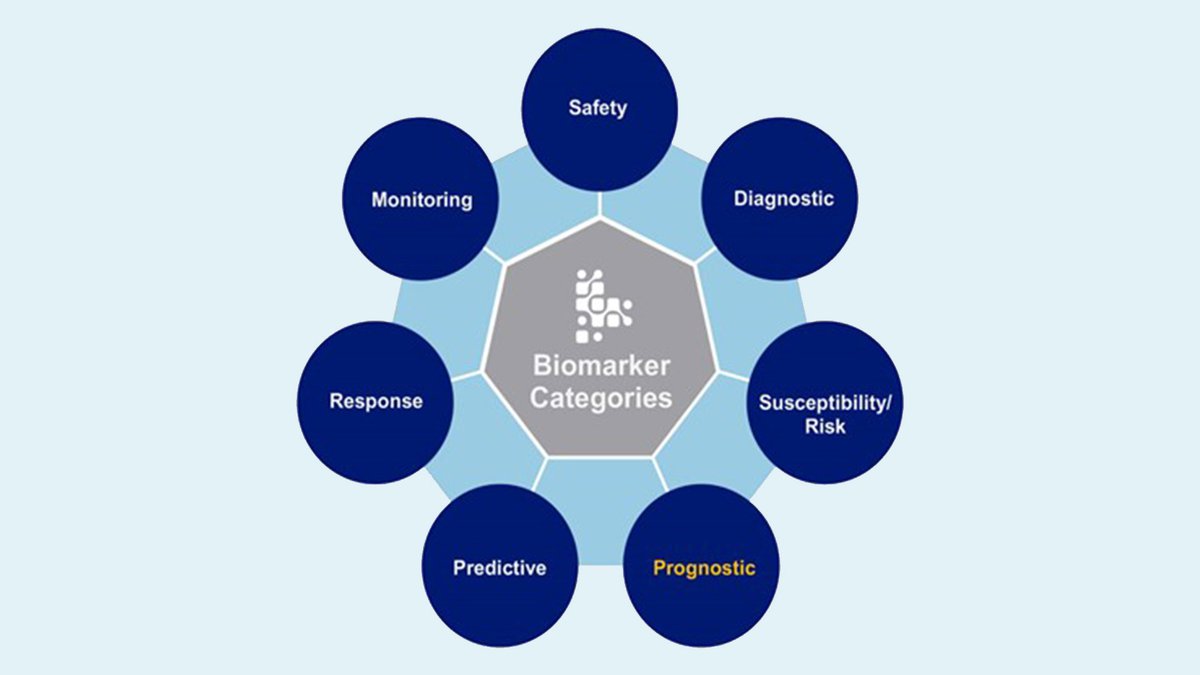A characteristic that is intentionally measured and evaluated as an indicator of normal biological processes, pathogenic processes, or pharmacological responses to therapeutic intervention is called biomarkers.
There are several types of biomarkers, the major ones are:
- Molecular characteristics
- Histological characteristics
- Radiographic characteristics
- Physiologic characteristics
Biomarkers are classified according to their usage and these categories are:
Image 1.0: Different categories of biomarkers. (Center for Drug Evaluation and Research, 2021)
Predictive biomarker:
A predictive biomarker is utilized to recognize people who are more likely than similar individuals without the biomarker to experience a favourable or unfavourable effect from exposure to a medical product or an environmental agent. Human leukocyte antigen allele (HLA)–B*5701 genotype is used as a predictive biomarker to analyze the risks for HIV patients before they receive abacavir treatment, this analysis gives the result of the risk of getting severe skin reactions. (FDA-NIH Biomarker Working Group, 2016c)
Susceptibility/Risk Biomarker:
Susceptibility/Risk Biomarker biomarker indicates the potential for developing certain diseases or conditions that do not currently have the disease or the condition. The level of C-reactive protein (CRP) works as a susceptibility/risk Biomarker that indicates a greater likelihood of incident coronary disease. (FDA-NIH Biomarker Working Group, 2020)
Diagnostic Biomarker:
A diagnostic biomarker is used to confirm the presence of a disease or condition of interest in a person. The level of blood sugar or hemoglobin A1c (HbA1c) is used as a diagnostic biomarker to detect patients with Type 2 diabetes mellitus (DM). (FDA-NIH Biomarker Working Group, 2020b)
Safety Biomarker:
Safety biomarkers are measured before or after exposure to a medical product or an environmental agent. The change in the level of safety biomarkers after exposure to a certain environment indicates the likelihood, presence, or extent of toxicity as an adverse effect. The level of neutrophils is used as safety biomarkers and is used when evaluating patients on cytotoxic chemotherapy to adjust the dose, determine the need to interrupt therapy or consider the use of growth factors. (FDA-NIH Biomarker Working Group, 2016b)
Monitoring biomarker:
Monitoring biomarkers are measured repeatedly in intervals of time to assess the condition of the disease or for evidence of exposure to (or effect of) a medical product or an environmental agent. Prostate-specific antigen (PSA) is used as a monitoring biomarker to assess the condition of prostate cancer. (FDA-NIH Biomarker Working Group, 2021)
Response biomarker:
Response biomarkers are utilized to make it appear that a biological response has occurred in an individual after this person was exposed to a medical product or an environmental agent. The Urinary level of glycosaminoglycan is used as a response biomarker to evaluate the effect of enzyme replacement therapy for patients with mucopolysaccharidosis type 1. (FDA-NIH Biomarker Working Group, 2016b)
Predictive biomarker:
A predictive biomarker is utilized to recognize people who are more likely than similar individuals without the biomarker to experience a favorable or unfavorable effect from exposure to a medical product or an environmental agent. Human leukocyte antigen allele (HLA)–B*5701 genotype is used as a predictive biomarker to analyze the risks for HIV patients before they receive abacavir treatment, this analysis gives the result of the risk of getting severe skin reactions. (FDA-NIH Biomarker Working Group, 2016c)
What are surrogate endpoints?
Biomarkers are essentially used to achieve surrogate endpoints. In clinical trials, Biomarkers are used as indicators to witness the result of a particular drug, this process substitutes the involvement of a direct measure of how a patient feels, functions, or survives and is known as surrogate endpoints. This makes it easier to find out the results of the trial earlier and may allow earlier approval of new drugs to treat serious or life-threatening diseases, such as cancer. Surrogate endpoints need to be validated to be taken into consideration, a valid surrogate endpoint must be supported by a clear mechanistic rationale and clinical data providing strong evidence that has an impact on the surrogate prediction and causes a benefit. Therefore the clinical trial gets approval without requiring extra adequacy data. For example, reduction in Hemoglobin A1C in diabetes patients in clinical trials. On the other hand, some surrogate endpoints are not validated and the results are not enough to approve the clinical trial, they are known as Reasonably Likely Surrogate Endpoints. The Reasonably Likely Surrogate Endpoint consists of a clear mechanistic and/or epidemiologic rationale but lacks insufficient clinical data to show that it is a validated surrogate endpoint. Thus, these endpoints need to be accelerated more for research work and need more data to be approved of. For example, Radiographic evidence of tumor shrinkage in some cancer types. (FDA-NIH Biomarker Working Group, 2020b)
How are biomarkers selected for clinical trials to surrogate endpoints?
The biomarkers that would be used in the clinical trials must be validated. To ensure that, several tests are carried out, but two major conditions must be fulfilled:
- There should be a correlation between the biological marker and the clinical endpoint.
- The marker must fully express the net effect of the intervention on the clinical efficacy endpoint.
Once the biomarker is qualified for the clinical trial, it will be publicly available and can be applied in any drug development program for the qualified context of use. (A Pathway and Approach to Biomarker Validation and Qualification for Osteoarthritis Clinical Trials, 2010; FDA-NIH Biomarker Working Group, 2020e)
To sum up, Biomarkers play an important role in improving drug development as well as in the broader biomedical research enterprise. The relationship between measurable biological processes and clinical outcomes is essential for expanding the therapeutic arsenal for all diseases and a deeper understanding of normal and healthy physiology. Since at least the 1980s, the need to use biomarkers as surrogate outcomes in large trials of major diseases, such as cancer and heart disease has been raised. widely discussed. It can serve as a true substitute for clinically relevant endpoints if we get the opportunity to comprehend the normal physiology of a biological process, the pathophysiology of that process in the disease state, and the effects of an intervention in near future. (What Are Biomarkers?, 2010)



3 comments